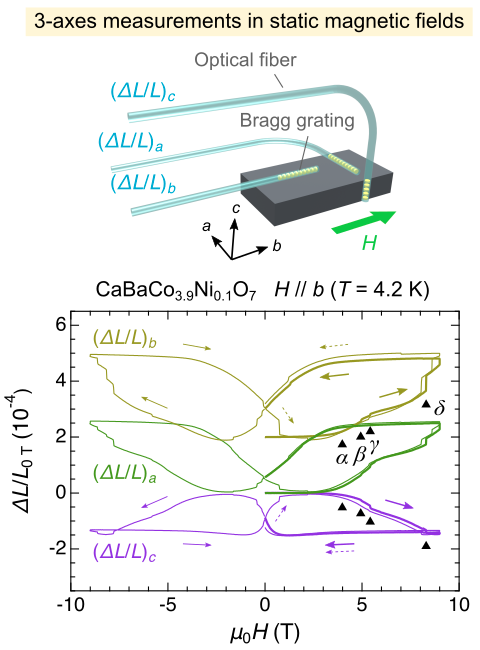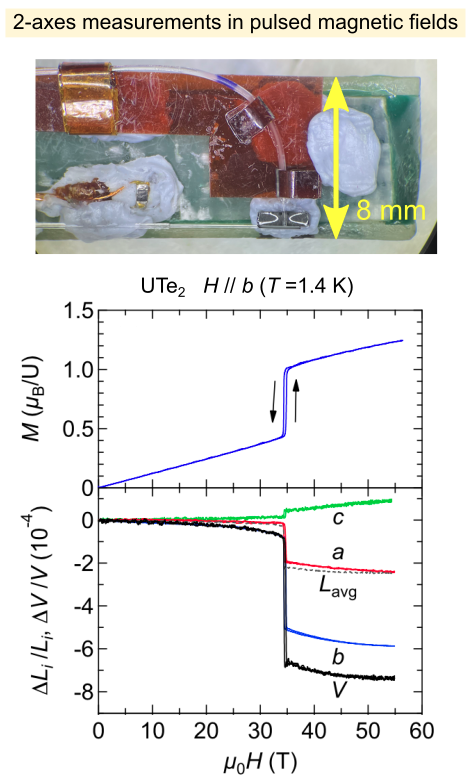Multi-axis dilatometry using the fiber Bragg grating (FBG) method
Strain measurements provide a powerful approach for detecting a variety of phase transitions, such as magnetic and valence transitions, and for probing their critical behavior. In condensed-matter experiments, capacitance- and resistive–strain-gauge–based techniques have been mainstream, but in recent years an optical method known as the fiber Bragg grating (FBG) technique has gained attention. In FBG measurements, an optical fiber with a Bragg grating inscribed in its core is glued to the sample, and the sample's strain is detected as a shift in the reflected Bragg wavelength. In addition to its simple setup, the method boasts a detection sensitivity of relative length changes of ΔL/L〜10-7. Thanks to its high-speed detection capability and immunity to electromagnetic noise, the FBG method can be applied even in pulsed high magnetic fields.
We have developed a method for multi-axis dilatometry using the FBG technique. For measurements in steady magnetic fields, we employed an interrogator (si155, Luna). By attaching three optical fibers orthogonally to the three principal axes of a single crystal, we succeeded in simultaneously detecting lattice strains along all three directions associated with changes in magnetization and electric polarization in multiferroic materials [A]. In pulsed high magnetic fields, the limited sample space makes the setup more challenging; nevertheless, using a nondestructive pulsed magnet, we realized simultaneous two-axis strain measurements and clarified both the volume change and the anisotropic magnetostriction accompanied by the metamagnetic transition in the heavy-fermion superconductor UTe2 [B]. Furthermore, even under destructive ultrahigh magnetic fields generated by the single-turn-coil method, we achieved simultaneous two-axis magnetostriction measurements up to a maximum field of 130 T and down to 5 K by developing a probe with an enlarged bore and a large helium-flow cryostat. These achievement enables discussion not only of magnetic phase transitions in conventional magnets but also of possible changes in valence and orbital states. It provides a powerful experimental complement to the recently developed “Single-shot powder X-ray diffraction in pulsed high magnetic fields using a portable single-turn-coil system”. We are actively pursuing broad collaborations using these techniques [C–E], and we would be delighted to hear from interested colleagues.
[B] A. Miyake, M. Gen et al., J. Phys. Soc. Jpn. 91, 063703 (2022). (Original paper [12])
[C] T. Kurumaji, M. Gen et al., Phys. Rev. Mater. 6, 094410 (2022). (Original paper [16])
[D] M. Gen et al., Phys. Rev. B 107, L020410 (2023). (Original paper [19])
[E] Y. Watanabe, M. Gen et al., Nat. Commun. 14, 1260 (2023). (Original paper [21])
We have developed a method for multi-axis dilatometry using the FBG technique. For measurements in steady magnetic fields, we employed an interrogator (si155, Luna). By attaching three optical fibers orthogonally to the three principal axes of a single crystal, we succeeded in simultaneously detecting lattice strains along all three directions associated with changes in magnetization and electric polarization in multiferroic materials [A]. In pulsed high magnetic fields, the limited sample space makes the setup more challenging; nevertheless, using a nondestructive pulsed magnet, we realized simultaneous two-axis strain measurements and clarified both the volume change and the anisotropic magnetostriction accompanied by the metamagnetic transition in the heavy-fermion superconductor UTe2 [B]. Furthermore, even under destructive ultrahigh magnetic fields generated by the single-turn-coil method, we achieved simultaneous two-axis magnetostriction measurements up to a maximum field of 130 T and down to 5 K by developing a probe with an enlarged bore and a large helium-flow cryostat. These achievement enables discussion not only of magnetic phase transitions in conventional magnets but also of possible changes in valence and orbital states. It provides a powerful experimental complement to the recently developed “Single-shot powder X-ray diffraction in pulsed high magnetic fields using a portable single-turn-coil system”. We are actively pursuing broad collaborations using these techniques [C–E], and we would be delighted to hear from interested colleagues.
References
[A] M. Gen et al., Phys. Rev. B 105, 214412 (2022). (Original paper [14])[B] A. Miyake, M. Gen et al., J. Phys. Soc. Jpn. 91, 063703 (2022). (Original paper [12])
[C] T. Kurumaji, M. Gen et al., Phys. Rev. Mater. 6, 094410 (2022). (Original paper [16])
[D] M. Gen et al., Phys. Rev. B 107, L020410 (2023). (Original paper [19])
[E] Y. Watanabe, M. Gen et al., Nat. Commun. 14, 1260 (2023). (Original paper [21])


